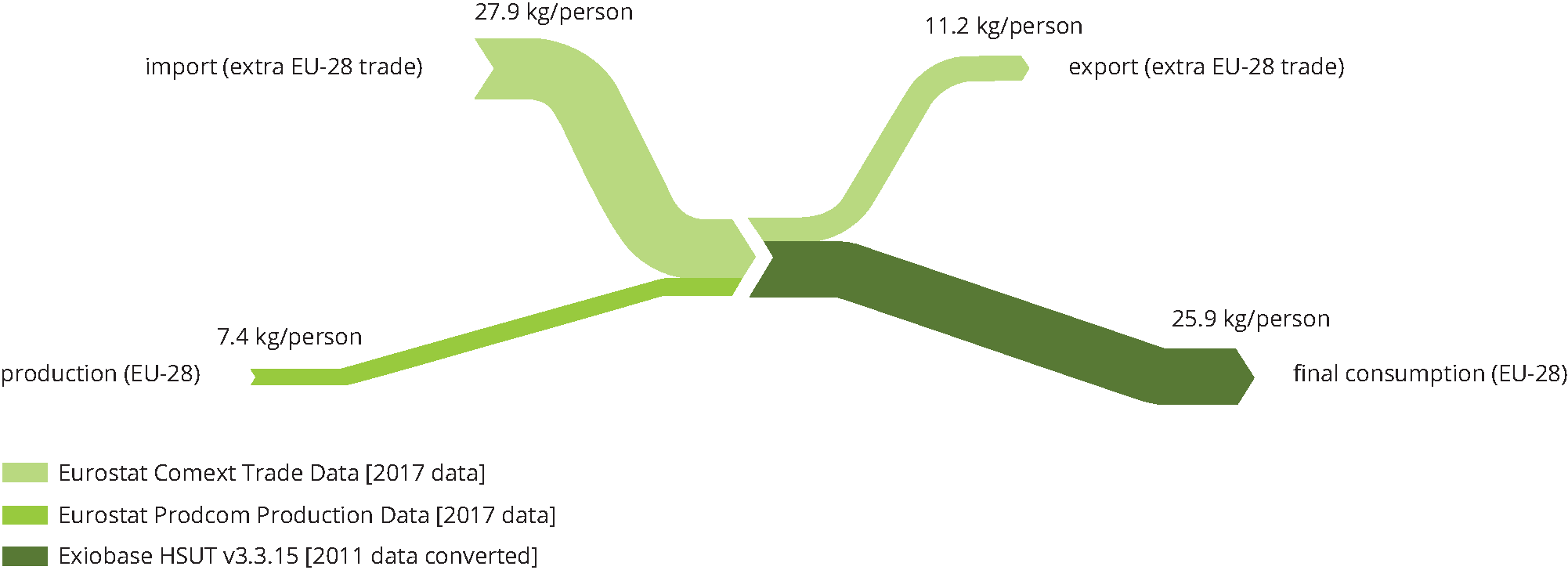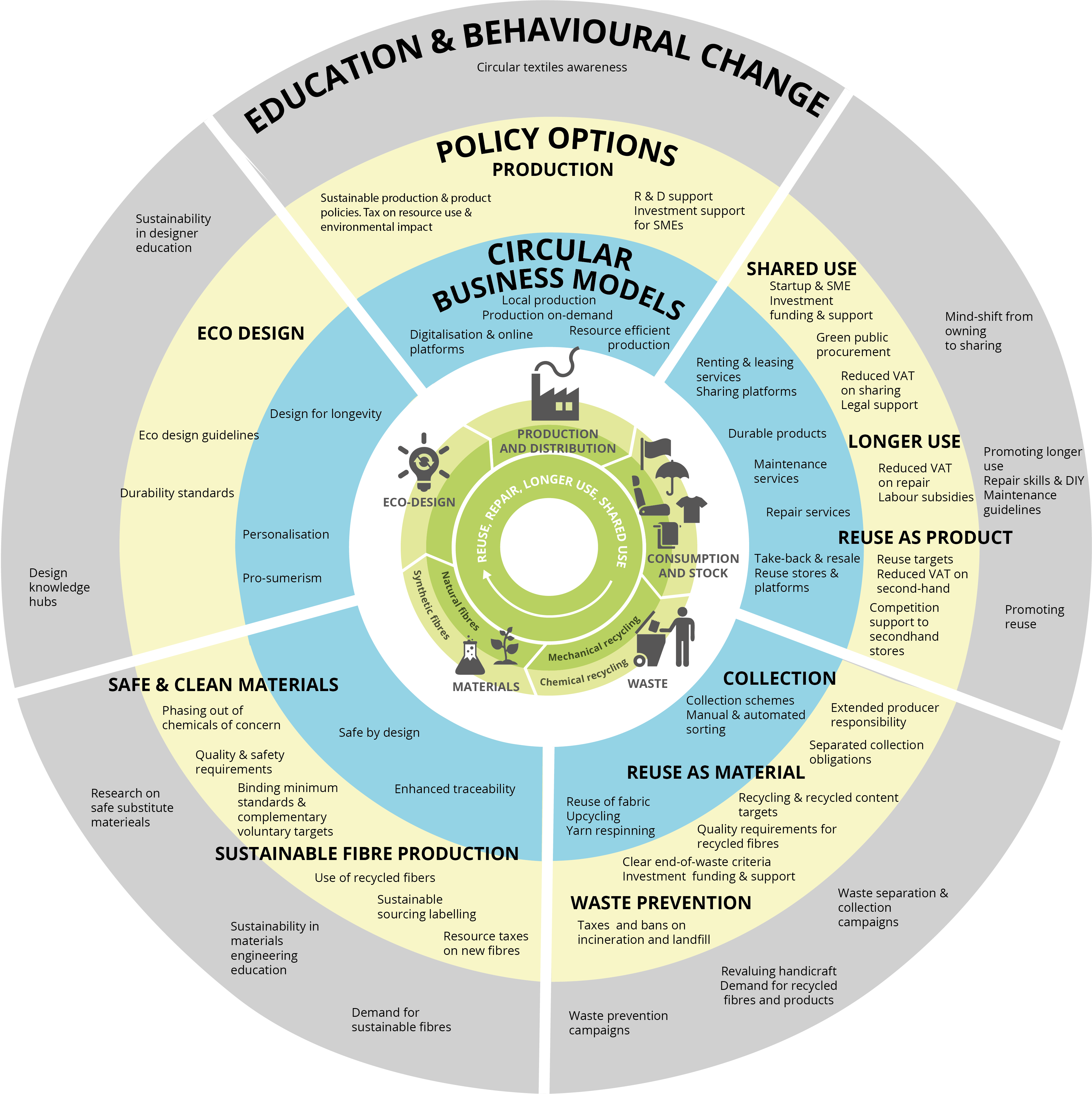An underpinning report of the EEA’s European Topic Centre on Waste and Materials in a Green Economy (ETC/WMGE) on textiles and the environment in a circular economy is available.
1. Textile consumption and production is highly globalised
The textiles market is highly globalised, and millions of producers and billions of consumers across the world are involved in so-called linear value chains. These chains — from raw material extraction to production, transport, consumption and waste — include little or no reuse or recycling. Since 1975, the global production of textile fibres has almost tripled. Today, 60 % of textile fibres are synthetic.
Polyester is the most commonly used fibre, produced from carbon-intensive processes requiring more than 70 million barrels of oil each year. The remaining fibres are mainly from cotton, which uses land and water. In 2014, the number of garments produced globally amounted to nearly 14 new items of clothing per person.
In the EU, there are around 171 000 companies in the textile (including wearing apparel) industry, employing 1.7 million people. In 2017, the EU produced 7.4 kg of textiles per person while consuming nearly 26 kg. The EU is therefore a net importer of textiles (mainly finished products from Asia).
Exports from the EU mainly comprise intermediate textile products, such as technical fibres and high-quality fabrics in which the European industry specialises (Figure 1).

Note: The waste flow of textiles from stock is not included in this scheme.
Details: Import, export, production and consumption flows of textile products, EU-28, 2017
Between 1996 and 2018, clothing prices in the EU dropped by over 30 %, relative to inflation. Since 2000, Europeans have purchased more pieces of clothing but spent less money in doing so. Fast fashion — the rapid changing of clothing lines and fashion trends — promotes increased consumption and reduces the life span of clothing.
EU consumers discard about 11 kg of textiles per person per year. The export of used clothes — mainly to eastern European countries, Asia and Africa — is significant and increasing. Used clothes not exported are mostly incinerated or landfilled. Textiles recycling is low.
2. There are high environmental, climate and social costs from textiles
Resource inputs, and the environmental and climate pressures from and impacts of the textiles system occur in every phase: from production of fibres and textile products to distribution and retail, use of textiles, collection, sorting and recycling, and final waste management. Pressures from and impacts of the textiles system, include the use of resources, land and chemicals, and the emission of greenhouse gases.
Resource use
Regarding total use of primary raw materials in the supply chain for consumption in the EU, clothing, footwear and household textiles represents the fourth highest pressure category after food, housing and transport (Figure 2). These textiles are also the fourth highest pressure category for water use.
Producing and handling all clothing, footwear and household textiles purchased by EU-28 households in 2017 used an estimated 1.3 tonnes of primary raw materials and 104 m3 of water per person. Some 85 % of these primary materials and 92 % of the water were used in other regions of the world, which is highest of all consumption domains.
Land use
Regarding pressures on land use from the upstream value chain for consumption in the EU, clothing, footwear and household textiles represent the second highest pressure category, following food consumed in the EU. The majority of pressures on land use come from outside the EU (93 %) and are largely a consequence of cotton cultivation.
Greenhouse gas emissions
Looking at climate change pressures, the production of textiles generates around 15-35 tonnes of CO2 equivalent per tonne of textiles produced. The upstream value chain of clothing, footwear and household textiles consumed in the EU is the fifth highest greenhouse gas emission pressure category. Its contribution is higher than the following consumption categories (Figure 3):
- recreation and culture
- beverages
- health
- restaurants and hotels
- communication
The production and handling of clothing, footwear and household textiles consumed in the EU-28 generated emissions of 654 kg CO2 equivalent per person in 2017. Only 25 % of this took place inside the EU-28.
Chemicals and water pollution
Textile production processes make use of a large amount and variety of chemicals. About 3 500 substances are used in textile production. Of these, 750 have been classified as hazardous for human health and 440 as hazardous for the environment. It is estimated that about 20 % of global water pollution is caused by dyeing and finishing textile products, affecting the health of workers and local communities.
Washing releases chemicals and microplastics into household waste water. It is estimated that about half a million tonnes of plastic microfibres are released into the ocean annually from washing plastic-based textiles.
Social pressures and impacts
In addition to the environmental and climate effects, the highly competitive, mostly linear business models in the sector — inside and outside Europe — can have detrimental social impacts. These include:
- poor rates of pay;
- poor working conditions;
- poor working environments in textile factories.
Avoiding suppliers outside Europe that use child labour is still a challenge in some regions. In addition, industrial accidents, including fatalities, occur regularly.
3. Business models and effective policies can drive a circular textiles economy
Private companies and public authorities are increasingly seeing the potential economic, social, environmental and climate benefits of a circular textiles system. Recently, circular business models focusing on circular textile design, sharing, recycling and reuse of textiles have surfaced. Such business models cannot be upscaled in isolation — it needs a change in the whole system supported by regulation and other policies.
In 2019, the European Commission identified textiles (apparel and fabrics) as a ‘priority product category for the circular economy’ in Sustainable products in a circular economy — Towards an EU product policy framework contributing to the circular economy. Furthermore, the new European Commission President announced in My agenda for Europe that she ‘will propose a new circular economy action plan focusing on sustainable resource use, especially in resource intensive and high-impact sectors such as textiles and construction’.
Education and behavioural change are an important part of the shift towards circular textiles to bring about behavioural change across the entire system — from production and processing to transport, consumption and waste.
The Ellen MacArthur Foundation describes a circular textiles system as one that is:
…restorative and regenerative by design and provides benefits for business, society and environment. A system in which clothes, fabrics and fibres are kept at their highest value during use, and re-enter the economy after use, never ending up as waste.
The EEA envisages the circular economy as one in which circularity is ensured in all phases of the lifecycle, including materials, eco-design, production and distribution, consumption and stock, and waste. It did so most recently in the 2019 EEA report Paving the way for a circular economy: insights on status and potentials.
Figure 4 illustrates a textiles system and shows options for circular business models, regulation and behavioural change in each phase of the lifecycle.

Source: ETC/WMGE and EEA.
The choice of materials and the design influence the environmental and climate impacts of textiles and the end-of-life options available in future. Circular business models need to be systematically scaled – and supported by policies - to enable sustainable sourcing of synthetic and natural fibres, including recycling and reuse of materials. When creating a circular economy for textiles, design choices are key. Safe and clean material cycles can be supported by:
- regulation and policy options targeted at quality and safety requirements;
- public demand for sustainable fibres;
- labelling and standards.
Resource taxes on new fibres could potentially increase the demand for used fibres. A strong focus on sustainability in design education curricula would be a powerful spur for a change in design culture. Extended producer responsibility is an option already used in other sectors to make producers responsible for the materials used throughout their whole lifecycle.
Mainstream business models often rely on short production and consumption cycles and low-cost labour and materials, generating social and environmental impacts. Circular business models should be systematically scaled and supported by policies to ensure more sustainable production in terms of:
- fair working conditions;
- fewer emissions;
- resource efficiency;
- safe chemical use;
- communicating standards to customers through labelling.
Waste and overproduction should be avoided, e.g. by shifting towards on-demand production. Policy instruments, such as harmonised product standards, efficiency requirements and labels, can support this shift.
In the use phase, business models should encourage collaborative consumption and longer use, e.g. by supporting leasing rather than buying, sharing platforms, take-back and resale, and second hand stores, and by revaluing repair and maintenance. Economic policy instruments — e.g. in the form of taxes, levies or value-added tax (VAT) adjustments — offer an opportunity to reduce virgin material use per capita and influence market dynamics in favour of sustainable textiles and repair services.
Increasing the use of green public procurement of textiles could pave the way for scaling up circular business models and increased awareness in society. Education of consumers and the use of labelling plays an important role in encouraging more sustainable textile use, such as reduced consumption, longer use and better maintenance (e.g. by reducing washing temperatures and avoiding tumble drying).
In the collection, recycling and waste treatment stages, it is important that circular business models enable recycling and reuse. Investment is needed to ensure sufficient capacity. EU policies oblige Member States to:
- collect textiles separately by 2025;
- ensure that waste collected separately is not incinerated or landfilled.
Policies also encourages setting up systems for repair and reuse of textiles to prevent waste in the first place. EU and national policymakers could consider future waste management targets, extended producer responsibility, and collection and take-back schemes.
Circular business models supported by regulation and other policies should not only be aimed at circularity on a small scale but also spur systemic change within the whole textiles system towards a circular economy, fuelled by sustainable and safe materials and products.


Document Actions
Share with others